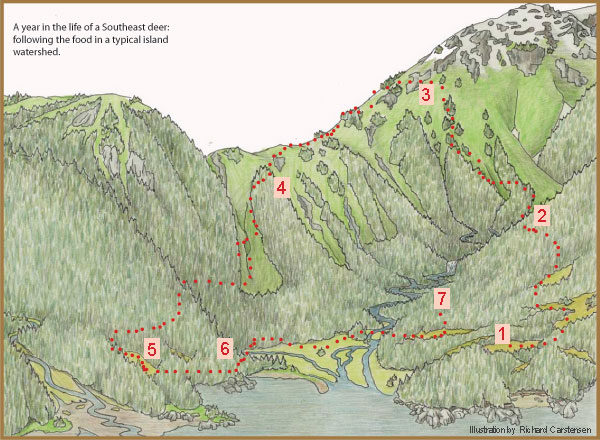Sitka Black-tailed Deer Hunting in Alaska
Annual Cycle of a Migratory Southeast Deer

1. Fawning
In late May and early June, black-tailed does drop their fawns. During late spring, deer are scattered from sea level to 1,500 ft. in search of new plant growth. Deer use old-growth forest and increase their use of open-canopy stands, fens, tidal meadows, and young clearcuts at this time.
2. Upward Migration
Throughout June, migratory deer continue to disperse off their winter ranges following the receding snow line on to upper forest slopes. Resident deer generally remain at lower elevations but use more forest openings for feeding.
3. Subalpine Summer Ranges
Migratory deer generally reach their ranges by the end of June or early July depending on weather and residual snowpack. On subalpine meadows between 1,800 and 3,000 ft., deer find abundant and nutritious herbaceous forage interspersed among stunted stands of Sitka spruce and mountain hemlock.
4. Fall Migration
Following the first high-country frosts in mid to late September, forage plants die and migratory deer move into the upper elevation forests. Throughout the next month, many deer move down to lower elevations as snow accumulates in the high country.
5. The Rut
The breeding season, or rut, begins in late October and continues through November. Deer are widely dispersed from sea level to 1,500 ft. Old-growth forests are important foraging habitats, but deer also make use of forest openings, and muskeg fringes during the rut.
6. Winter Range
Deer distribution is most limited during winter. From December through March, deer in Southeast are generally confined to old-growth forest winter ranges below 1,000 ft. Southern exposures generally accumulate less snow and provide greater access to evergreen forbs such as bunchberry dogwood and trailing raspberry. Deer move up and down forested slopes following changes in the snow pack throughout the winter. During deep snows, medium and large-tree old growth hemlock spruce forests provide the best winter habitat.
7. Spring Snow Melt
Spring is a transition period as deer begin to expand their movements beyond the confines of their winter range in search of new plant growth. Wet, open-canopy forests with newly emergent skunk cabbage shoots are important foraging sites for deer in spring. Deer can also be seen foraging along upper beaches and young clearcuts during spring.
